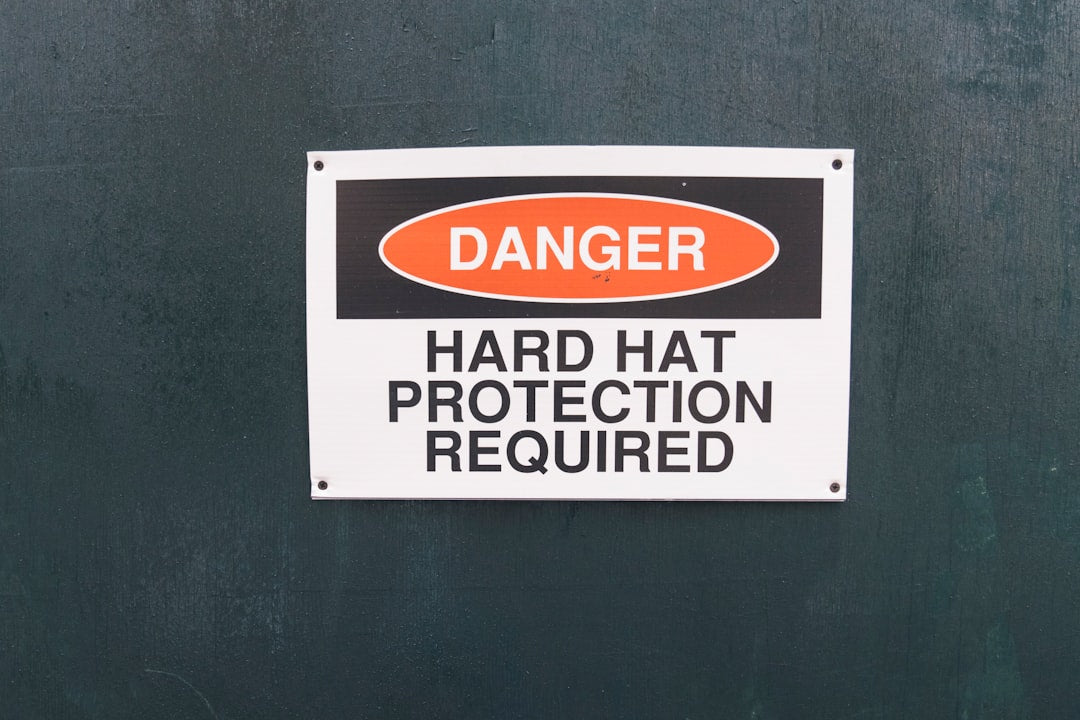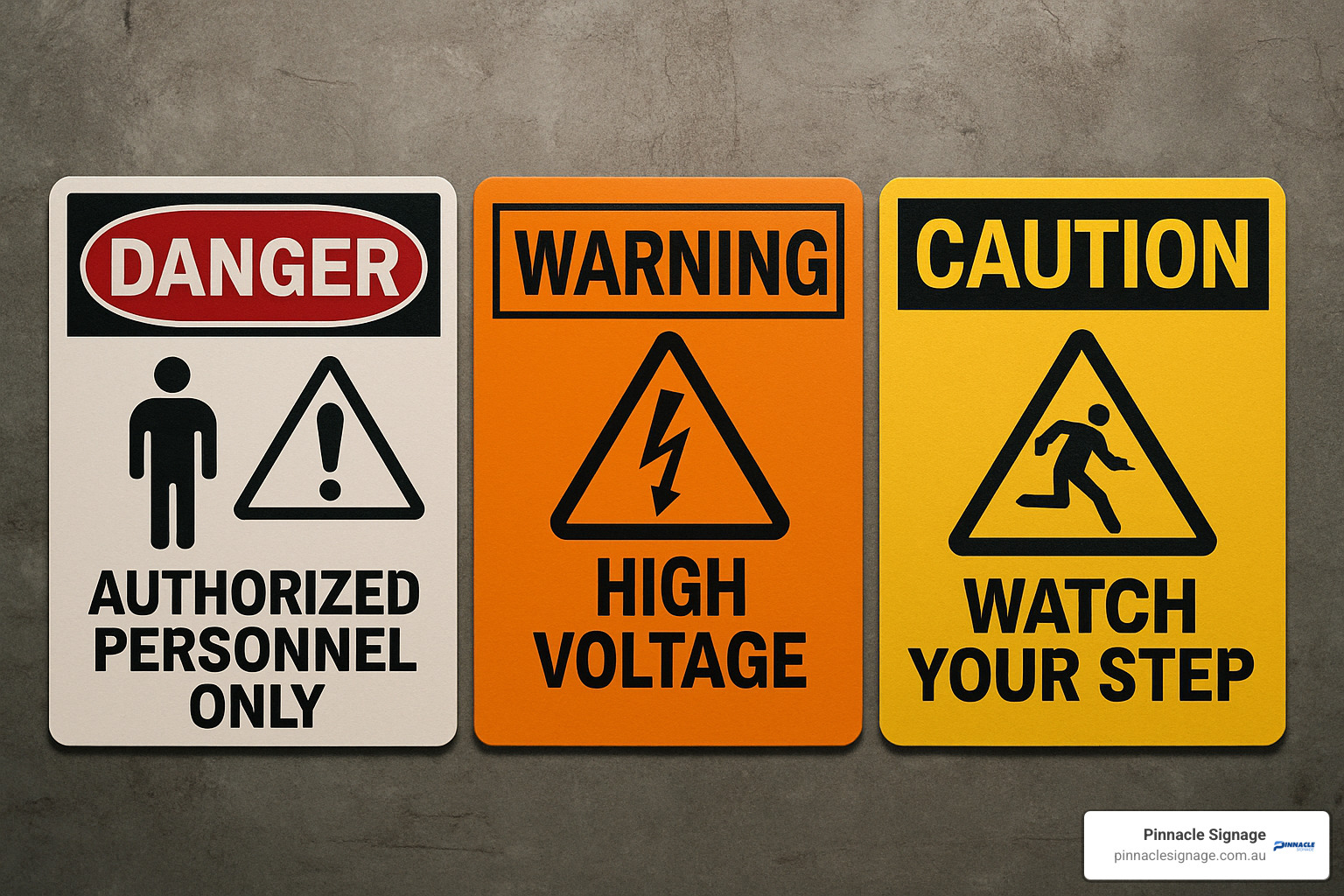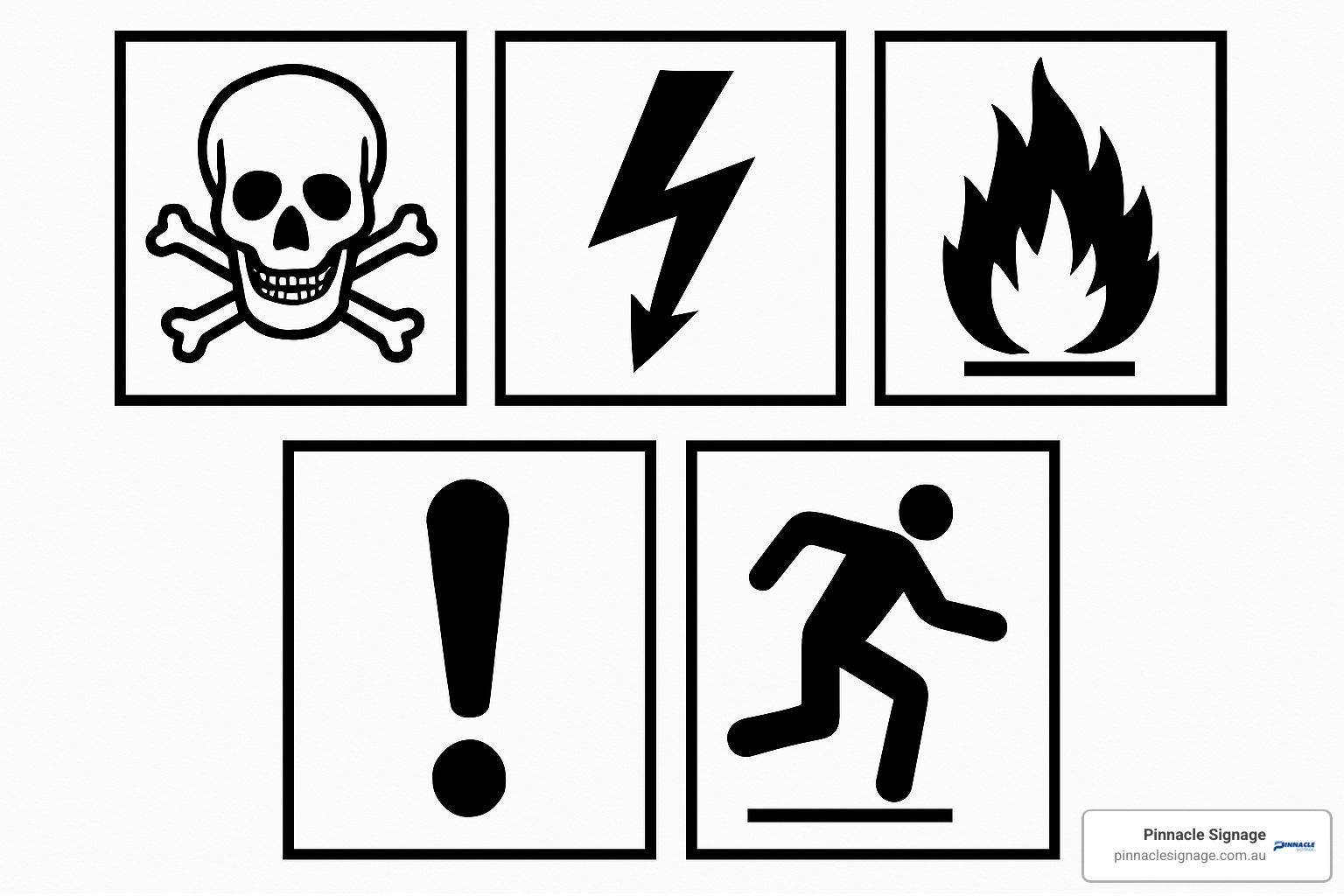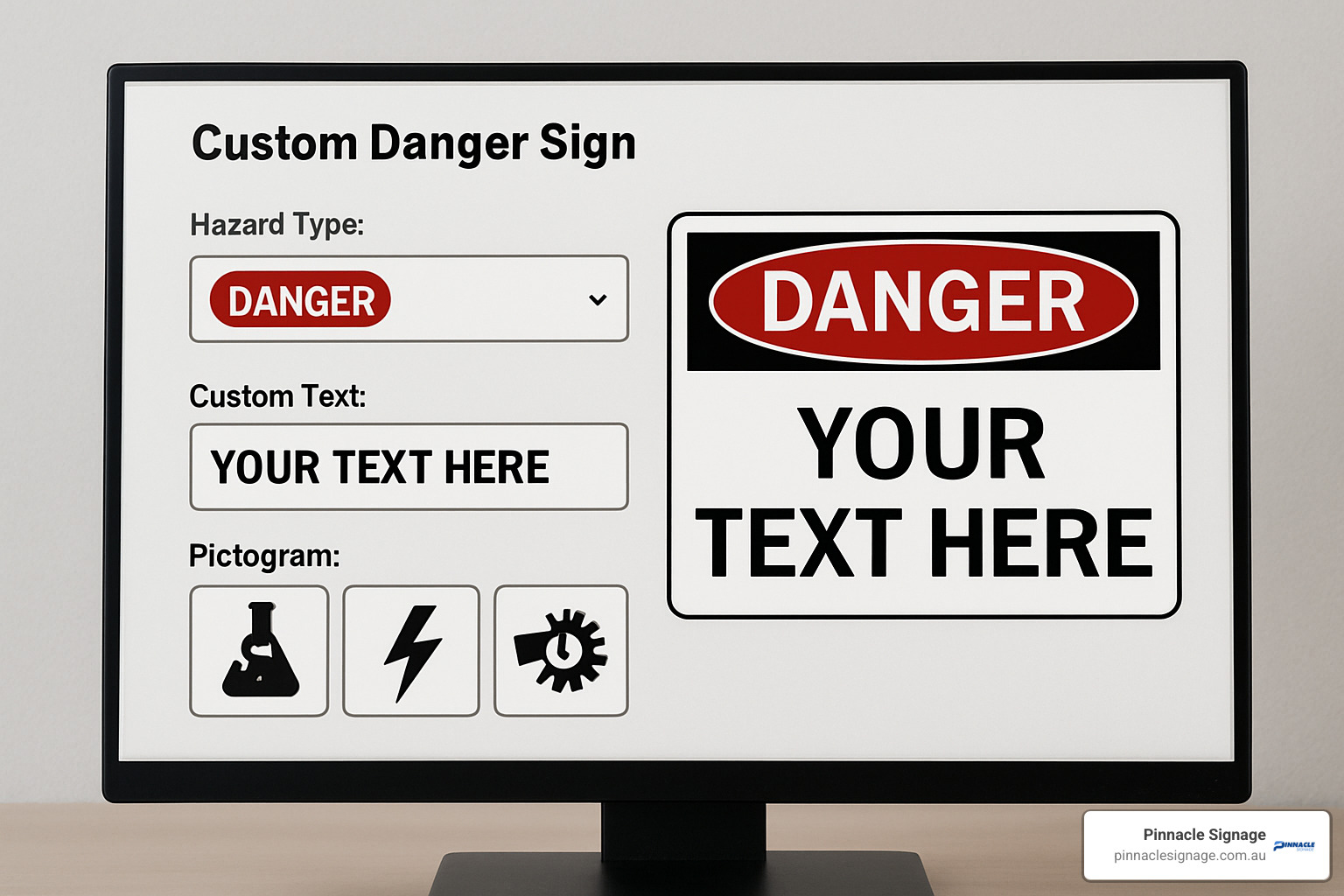
Signs of Trouble – Understanding Danger Labels and Safety Signage
Understanding the Critical Role of Danger Labels Signs in Workplace Safety
Danger labels signs are specialized safety markers used to communicate immediate, life-threatening hazards in workplaces and public spaces. They serve as the first line of defense against serious accidents and injuries.
Danger signs differ significantly from other safety signage like caution (yellow) or warning (orange) signs. According to OSHA Standard 29 CFR 1910.145, danger signs should be used only where an immediate hazard exists and special precautions are necessary. This strict application helps maintain their effectiveness - when workers see a danger sign, they know the threat is serious and immediate.
The design elements of danger signs aren't arbitrary - they're carefully standardized to ensure instant recognition across industries and locations. The stark contrast of red, white, and black creates maximum visibility, even in poor lighting conditions.
Material selection matters too. In harsh industrial environments, paper printouts or cardboard signs simply won't last. Proper danger signs use durable materials like laminated vinyl, high-tack polyester, or aluminum that can withstand chemical exposure, moisture, UV radiation, and physical wear.
I'm Doug Lindqvist, General Manager of Pinnacle Signage, and through my years in the safety and industrial supply space, I've seen how properly implemented danger labels signs can prevent serious workplace incidents and save lives. Our team specializes in creating compliant, durable danger signage that meets Australian standards while providing the rapid turnaround that safety-conscious businesses need.
Common danger labels signs vocab:
What You'll Learn
In this comprehensive guide, we'll walk you through everything you need to know about danger labels signs, including:
- Australian and international standards governing safety signage
- When to use danger signs versus other hazard communication
- Design requirements that ensure compliance and effectiveness
- Material options for different environments
- Proper placement for maximum visibility
- Customisation options for specific workplace hazards
This information is vital for business owners, safety managers, and site supervisors across industries including manufacturing, construction, warehousing, chemical processing, and utilities. By implementing proper danger labels signs, you'll not only meet your legal obligations but also significantly reduce workplace incidents and protect your most valuable asset—your people.
Regulations & Standards for Danger Labels Signs
When it comes to keeping people safe, Australia doesn't leave things to chance. That's why we have clear guidelines for danger labels signs that help protect workers across the country.
Australian Standards and Regulations
Here in Australia, our primary guideline is AS 1319 (Safety Signs for the Occupational Environment). This isn't just a suggestion – it's the blueprint that specifies exactly how safety signs should look, from their colours and design to where they should be placed.
Australian Work Health and Safety (WHS) legislation places the responsibility squarely on employers' shoulders. You have a duty of care to identify hazards and implement appropriate control measures – and proper signage is a crucial part of that obligation.
Like a traffic light system for workplace safety, AS 1319 organises hazard signs into a clear hierarchy:
- Danger signs - These red alerts flag immediate, life-threatening hazards
- Warning signs - These orange notices highlight potential hazards that could cause serious injury
- Caution signs - These yellow markers indicate potential hazards that might result in minor injury
When to Use 'DANGER' vs 'WARNING' vs 'CAUTION'
These aren't interchangeable terms – they communicate very specific levels of risk:
DANGER should be reserved for the most serious situations – those with a high probability of death or serious injury if not avoided. Think high voltage electrical panels, confined spaces with hazardous atmospheres, or areas where chemical exposure could be immediately harmful.
WARNING indicates hazards that could result in death or serious injury, but where the risk isn't quite as immediate as with DANGER situations. Examples include machinery with moving parts that could cause crushing injuries or areas where hearing protection is required.
CAUTION is for hazards that might cause minor or moderate injuries. These include trip hazards, hot surfaces that could cause burns, or areas where safety glasses should be worn.
Using the wrong signal word isn't just a technical error – it can have serious consequences. If you plaster DANGER signs everywhere, including for minor risks, workers may become desensitised and potentially ignore truly dangerous situations. On the flip side, using a mild CAUTION sign for a life-threatening hazard fails to communicate the true severity of the risk.

Key Design Mandates for Danger Labels Signs
The design elements of danger labels signs aren't just about looking good – they're carefully standardised to ensure instant recognition, even in challenging conditions:
- Header: A vibrant red background with crisp white "DANGER" text that stands out
- Message panel: Clean white background with black text for maximum readability
- Border: A red border framing the entire sign to draw attention
- Pictograms: Simple black symbols on white backgrounds when used
This isn't just about aesthetics – it's about creating a visual language that communicates risk instantly, whether viewed from across a warehouse floor or in dim lighting conditions. The stark contrast between red, white, and black makes danger signs immediately noticeable and distinct from other safety signage.
Text legibility is paramount, with minimum letter heights based on viewing distance (we'll cover more about this in the Placement section). Any pictograms should be simple, instantly recognisable, and consistent with established safety symbols.
At Pinnacle Signage, we ensure all our danger labels signs meet these strict design requirements while still allowing you to customise the hazard message to address your specific workplace risks. We understand that while standards must be met, every workplace has unique hazards that require clear communication.
Design Elements: Colour, Symbols & Materials
When it comes to danger labels signs, every visual element plays a crucial role in communicating hazards quickly and effectively. The right combination of colours, symbols, and materials doesn't just satisfy regulations—it could literally save lives.
Signal Word & Colour Pairings
The colour coding system for safety signage isn't random—it's been carefully developed to trigger immediate recognition in our brains, even before we read a single word:
Red headers with white "DANGER" text instantly signal the highest level of hazard. Your brain processes this colour combination faster than you can read the words, creating an immediate alert response.
Orange headers with black "WARNING" text indicate serious hazards that need attention but may not pose immediate life-threatening danger.
Yellow headers with black "CAUTION" text highlight potential hazards that could cause minor or moderate injuries.
For non-hazard information, blue "NOTICE" signs and green safety instruction signs round out the system.
This colour-coding approach works across language barriers and varying literacy levels, making it incredibly effective in diverse workplaces. It's fascinating how our brains process these colour signals almost instinctively—a red danger sign can trigger alertness even in your peripheral vision.
Symbols and Pictograms
A well-designed pictogram can communicate a hazard in milliseconds—much faster than reading text. That's why danger labels signs often incorporate universal symbols that convey specific risks.

The most effective symbols are simple and bold—like the skull and crossbones for toxic hazards or the lightning bolt for electrical dangers. These symbols work because they create instant associations with danger. Even workers who don't speak the local language or who are viewing the sign from a distance can understand the risk.
At Pinnacle Signage, we've seen how powerful these visual elements can be. In busy environments where workers might not have time to stop and read detailed instructions, these symbols serve as critical visual shortcuts to safety information.
Material Options & Life Expectancy
Even the most perfectly designed sign fails if it deteriorates in harsh conditions. That's why choosing the right material for your danger labels signs is just as important as getting the colours and symbols right.
Self-adhesive vinyl signs are perfect for indoor applications and clean surfaces. They're flexible, easy to apply, and cost-effective at $15-$30 for standard sizes. While they'll last 2-5 years indoors, they're not your best bet for outdoor applications exposed to harsh weather.
Rigid plastic signs offer a step up in durability, lasting 5-7 years even in sheltered outdoor areas. They won't rust or corrode, and they offer decent impact resistance for $25-$45. They're a great middle-ground option for many Australian businesses.
For truly demanding environments, aluminium signs are the gold standard. They'll withstand the harsh Australian sun, coastal salt spray, and industrial conditions for 7-10+ years. At $35-$65 for standard sizes, they're an investment in long-term safety.
Working in areas with poor lighting? Reflective material signs could be a lifesaver, literally. They improve visibility in low-light conditions and at night, making them ideal for emergency exits or outdoor hazard warnings. They typically range from $40-$75.
At Pinnacle Signage, we've developed our laminated vinyl labels to resist everything from harsh UV rays to chemical spills and abrasion. For extremely challenging environments, our 0.040" aluminium signs with UV-cured printing have proven their worth time and again, standing up to the toughest Australian conditions for up to a decade.
Choosing the right material isn't just about durability—it's about ensuring your safety message remains clear and visible for years to come, protecting your team and keeping your workplace compliant with safety standards.
Placement, Visibility & Maintenance
Let's face it - even the most beautifully designed danger labels signs won't do their job if nobody can see them! Proper placement is just as crucial as the design itself. Think of it this way: a sign is only effective when it's seen before someone encounters the hazard.
Best-Practice Placement Checklist
When installing your danger labels signs, think strategically about where people will be looking. Place signs at all entry points to hazardous areas, ensuring workers and visitors see them before they're exposed to any danger. For machinery, mount signs directly on or next to dangerous equipment, especially near pinch points or operator stations where accidents are most likely to happen.
Electrical panels need clear signage right on the panel doors, while confined spaces should have prominent signs at every possible entry point. For chemical storage areas, place signs both at entrances and on individual containers as required by regulations.
Always consider the line of sight - can your sign be seen from all approach angles? Mounting at eye level (about 1.5-1.8 metres from the floor) works best in most situations. And don't forget about lighting! Ensure there's adequate illumination, or opt for reflective materials in dimly lit areas.
Nothing defeats the purpose of safety signage quite like having it blocked by shelving, equipment, or materials. I've visited countless workplaces where perfectly good signs were rendered useless because someone stacked boxes in front of them. Keep those sightlines clear!
Sizing Based on Viewing Distance
Size matters when it comes to danger labels signs. The viewing distance determines how big your signs should be:
For close-range viewing (up to 3 metres), a 225 x 300 mm sign works well. Medium range (3-6 metres) calls for 300 x 450 mm signs, while long-range viewing (6-12 metres) requires larger 450 x 600 mm signs. For anything beyond 12 metres, you'll need custom large-format signage.
Here's a handy rule of thumb for text size: for every 10 metres of viewing distance, your letters should be at least 5 cm tall. So if workers need to read your sign from 20 metres away, the main text should be at least 10 cm in height.
Common Mistakes to Avoid with Danger Labels Signs
Over the years at Pinnacle Signage, we've seen plenty of well-intentioned safety efforts undermined by common mistakes. Using the wrong signal word is a big one - marking minor hazards with DANGER signs dilutes their impact, while using CAUTION for severe hazards doesn't communicate the true risk.
Poor placement is another frequent issue. Signs hidden behind equipment or mounted too high aren't doing anyone any favours. Similarly, using signs that are too small to read from the necessary distance defeats their purpose entirely.
Material choice matters too. Indoor-rated materials will quickly deteriorate in outdoor environments, leaving you with faded, illegible warnings. Speaking of fading, don't wait until signs are completely unreadable before replacing them - by then, they've already failed at their job.
Sign fatigue is real! Too many signs in one area can cause workers to tune out important messages. Keep your signage focused and meaningful. And while we're talking about clarity, inconsistent design or non-standard colours can confuse people who are trained to recognize standard safety formats.
In multicultural workplaces, language barriers present a unique challenge. Consider bilingual signs where appropriate to ensure everyone understands the hazards they face.
Maintenance and Auditing
Safety signage isn't a "set and forget" proposition. Develop a regular inspection routine:
Monthly visual checks can catch damage or obstruction issues before they become problems. Quarterly cleaning keeps your signs visible and professional-looking. An annual comprehensive audit ensures all required signage is still in place and compliant with current standards.
Most importantly, replace damaged or faded signs immediately. A faded warning is almost as bad as no warning at all.
At Pinnacle Signage, we help businesses develop comprehensive signage maintenance programs custom to their specific environments. Our team can recommend replacement schedules based on the materials used and the conditions they'll face, ensuring your danger labels signs remain effective protectors of workplace safety for years to come.
Choosing & Customising Danger Labels Signs
Selecting the right danger labels signs isn't just about ticking a compliance box—it's about effectively communicating risks to keep your team safe. At Pinnacle Signage, we've helped thousands of Australian businesses find the perfect balance between compliance and clear communication.
Hazard Assessment Process
Before you even think about ordering signs, take a step back and look at your workplace through fresh eyes. A proper hazard assessment forms the foundation of effective safety signage:
Start by walking through your facility and identifying all potential dangers. Look high and low—sometimes the most serious hazards aren't immediately obvious. Once you've spotted them, categorise these risks by type and severity. Is it a chemical hazard that could cause immediate harm? A mechanical risk from moving parts?
Next, determine what control measures you already have in place. Signage is actually your last line of defence after engineering controls and administrative procedures. For those remaining hazards that require clear warnings, select the appropriate signal word based on severity—DANGER for immediate, life-threatening risks; WARNING or CAUTION for less severe hazards.
Finally, map out exactly where these signs need to go for maximum visibility, and consider the environmental conditions they'll face. Will they be exposed to harsh sunlight, chemicals, or frequent cleaning? This helps determine the right materials for lasting effectiveness.
Creating Application-Specific Labels
While standard signs work for common hazards, many Australian workplaces have unique risks that deserve customised attention. We've created thousands of application-specific danger labels signs for clients across industries:
For chemical storage areas, we can design signs that include specific chemical names, CAS numbers, and required PPE—making compliance with Australian WHS regulations straightforward.
Electrical contractors love our custom voltage warning signs that specify exact voltages (like "DANGER - 11,000 VOLTS") and include arc flash boundary information custom to their equipment.
For confined spaces—a significant hazard in many industrial settings—we create signs that detail specific entry permit requirements and atmospheric testing procedures relevant to your particular space.
Our machinery safety signs can include lockout/tagout procedures specific to your equipment, highlighting particular pinch points or machine-specific shutdown instructions that generic signs simply can't provide.

Bilingual and Multilingual Options
Australia's wonderfully diverse workforce often means one language isn't enough. We're proud to offer bilingual and multilingual danger labels signs that maintain compliance while ensuring everyone understands the risks, regardless of their primary language.
Our most requested language combinations include English/Chinese, English/Arabic, and English/Vietnamese, reflecting Australia's multicultural workforce. We also regularly produce signs in English/Greek, English/Italian, and English/Spanish.
When creating multilingual signs, we maintain the standard danger sign format while carefully incorporating translated text that remains clear and legible. The pictograms become even more valuable in these situations, providing visual cues that transcend language barriers entirely.
Ensuring Compliance Before Printing
Getting your danger labels signs right the first time saves time, money, and potentially lives. Before we send your design to production, we recommend these essential compliance checks:
Double-check your signal word choice against the actual severity of the hazard—using "DANGER" for minor risks can create "warning fatigue" where workers start ignoring all signs. Verify that your design elements match AS 1319 requirements with the proper colours and formats.
Review your text for clarity and brevity—in an emergency, people won't stop to read paragraphs. Confirm you've included appropriate pictograms that visually reinforce your message, and validate that your sign size is appropriate for the viewing distance.
At Pinnacle Signage, we provide digital proofs of all custom signs before production, giving you a chance to verify everything looks right. Our team knows Australian safety standards inside and out, and we're happy to offer suggestions if we spot potential compliance issues.
We believe great safety signage is about more than just following rules—it's about creating clear communication that genuinely protects people. That's why we take the time to get it right, from material selection to design elements to final placement recommendations. Learn more about our custom danger sign process or browse our ready-made danger signs collection to get started.
Frequently Asked Questions about Danger Labels Signs
What hazards legally require a 'DANGER' header?
Not all workplace hazards need the highest level of warning. Under Australian standards, we reserve the DANGER signal word for truly serious situations—those immediate hazards that could lead to death or serious injury.
Think about electrical panels carrying 240V or higher, confined spaces where hazardous atmospheres might lurk, or areas where toxic chemicals or gases pose an immediate threat. Other examples include unprotected fall hazards, machinery with exposed moving parts that could crush or amputate limbs, and explosive environments.
Here's why this matters: using DANGER signs for less serious hazards creates what safety professionals call "warning fatigue." When workers see these red signs everywhere, even for minor risks, they eventually become numb to them. Then, when they encounter a genuinely dangerous situation, they might not give it the attention it deserves.
How big should a sign be for a 10-metre viewing distance?
Size matters when it comes to safety signage! For your danger labels signs to be effective from 10 metres away, you'll need to consider several dimensions:
Your sign should be at least 450 x 300 mm overall. The main message text needs to be at least 5 cm tall to be legible from that distance, with the signal word "DANGER" appearing even larger to grab attention. Any pictograms should stand at least 10 cm tall.
These aren't arbitrary numbers—they're carefully calculated to ensure that workers can spot and read the sign before they're exposed to the hazard. Too small, and the warning comes too late. Just right, and you've created an effective safety barrier.
Can I print my own labels and still comply with AS 1319?
While the DIY approach is tempting (and technically possible), creating truly compliant safety signs in-house presents several challenges that make professional production the smarter choice.
Standard office printers struggle to reproduce the exact shades of red, yellow, and orange required by AS 1319. The materials typically available for office printing lack UV resistance, moisture protection, and chemical resistance—all crucial in industrial environments. Most consumer-grade adhesives simply can't handle the conditions in manufacturing facilities or outdoor settings.
There are also practical limitations: office printers generally can't produce the larger signs needed for longer viewing distances, and in-house printing often leads to inconsistencies in colour and format across your signage.
At Pinnacle Signage, our industrial-grade materials and printing processes meet all Australian standards, with standard danger labels signs starting from just $19.75—a small price for compliance and peace of mind.
How often should danger signs be replaced?
There's no one-size-fits-all answer here, as the lifespan of danger labels signs depends on several factors working together.
Material choice plays a major role—vinyl signs typically serve you well for 2-5 years, while aluminium signs can remain effective for 7-10+ years. Environment matters too: indoor signs naturally outlast those battling weather, chemicals, or abrasion. Sun exposure is particularly harsh on vinyl signs, causing colours to fade over time.
As a practical approach, I recommend regular sign inspections. Look for signs where:
- Colours have noticeably faded
- Text has become difficult to read
- Physical damage has occurred
- Information is outdated or incorrect
Any of these conditions warrant immediate replacement. At Pinnacle Signage, we're happy to help you develop a replacement schedule custom to your specific environment and the materials you've chosen.
Are electronic or digital danger signs compliant?
Electronic or digital danger labels signs can absolutely comply with Australian standards, provided they meet all the design requirements for colour, format, and visibility. However, they do come with their own set of considerations.
Power failures present the most obvious challenge—electronic signs may go dark during outages, precisely when hazard communication might be most critical. Brightness levels must be sufficient for all lighting conditions, and the electronic components need proper protection from environmental factors. They also typically require more regular maintenance than traditional signs.
For these reasons, we generally recommend using traditional danger labels signs as your primary safety communication method, with electronic signs serving as helpful supplements where appropriate. This belt-and-braces approach ensures your safety messaging remains visible and effective in all circumstances.
Conclusion
Choosing the right danger labels signs isn't just about ticking a compliance box—it's about creating a safer workplace where everyone goes home safely at the end of each day.
Throughout this guide, we've explored how proper safety signage serves as your first line of defense against workplace accidents. From understanding the critical difference between danger, warning and caution signals to selecting materials that can withstand Australia's harsh conditions, every detail matters when communicating life-threatening hazards.
Remember these essential points as you evaluate your safety signage needs:
Always match the signal word to the actual risk level—danger labels signs should only mark immediate, serious hazards that could cause death or severe injury. Using the wrong level dilutes their impact and puts your team at risk.
The stark red-white-black design of danger labels signs isn't just visually striking—it's carefully engineered to create instant recognition even in poor lighting or from a distance. This visual language speaks volumes before anyone reads a single word.
Your environment should guide your material choice. While vinyl signs might work perfectly in a climate-controlled office, they'll quickly deteriorate in a sun-drenched mining site or chemical processing facility. Investing in quality materials like our UV-resistant aluminium signs (starting from $35) provides years of reliable hazard communication.
Here at Pinnacle Signage, we've helped countless Australian businesses—from small workshops in Wagga Wagga to nationwide industrial operations—create effective safety communication systems. We understand the unique challenges of Australian workplaces, from the scorching sun that fades inferior signs to the specific regulatory requirements of different industries.
We're not just sign makers—we're your partners in workplace safety. Our team can help you conduct a comprehensive signage audit to identify gaps in your hazard communication, recommend appropriate solutions, and deliver high-quality danger labels signs that meet all Australian standards.
Take the next step toward a safer workplace today. Whether you need standard signs from our extensive catalogue or custom solutions for unique hazards, we're ready to help with fast turnaround times and nationwide delivery.
Explore our range of ready-made and custom danger signs or contact us through our website for a friendly chat about your requirements.
Because when it comes to workplace safety, clear communication through proper danger labels signs isn't just about compliance—it's about making sure everyone makes it home safely at the end of each day.
